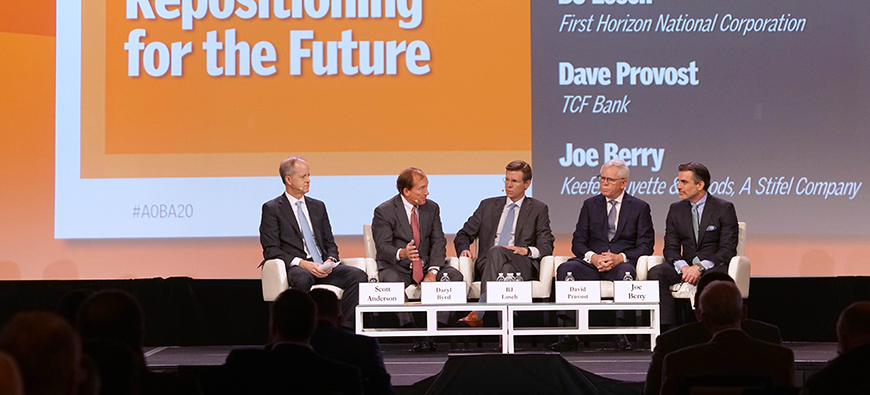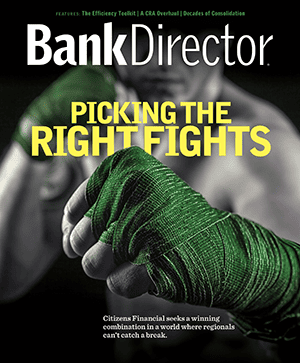
Four Takeaways from One of the Biggest Events in Banking
One of
the marquee events in banking has concluded, and what promises to be an
interesting and important year for many institutions is underway.
More than 1,300 attendees, including 800-plus bankers, assembled in Phoenix for Bank Director’s 2020 Acquire or Be Acquired Conference. We heard from investment bankers, attorneys, accountants, fintechs, investors and – yes, other bankers – about the outlook for growth and change in the industry. There was something for everyone.
To that
end, I asked my editorial colleagues to share with me their biggest takeaways
from the conference. Here’s what we came away with.
Mergers Get Political
The
discussions I found to be the most surprising were executives’ concerns about political
regime change, especially as it relates to their decisions around M&A or
remaining independent.
“The elephant in the room is that there are two radicals running for president right now,” says Dory Wiley, CEO of Commerce Street Capital. And it’s not just investment bankers who see risk in the potential political change.
Executives
of both Lafayette, Louisiana-based IBERIABANK Corp. and Memphis,
Tennessee-based First Horizon National Corp. cited political uncertainty on the
horizon in their motivations to combine through a merger of equals, which was
announced in November 2019. Daryl Byrd, IBERIA’s current president and CEO, says
the $31.7 billion bank saw the potential for political risk evolving into
economic risk at a time when competition from the biggest banks for customers
and deposits remains high. First Horizon saw emerging regulatory risk if the
political tides turned.
“Generally speaking, we like a fair and balanced regulatory environment. We knew with the upcoming election that the regulatory would, at best, stay the same, but that it could get worse. So that was a consideration,” says BJ Losch, CFO at $43.3 billion First Horizon.
The
mention of these concerns – and the magnitude of the response – has interesting
implications. Banks operate in all types of environments, and many elements are
outside of executives’ control. The industry has demonstrated resilience and
flexibility before, during and after the financial crisis. What are the
remaining 5,000-plus banks supposed to do in the face of the impending
presidential election?
Kiah Lau Haslett, managing editor
Tipping the Scales
The most remarkable observation I had is how
important scale has become in the banking industry. It was clear from comments
at the conference that the large banks have been taking deposit market share
away from the smaller banks, and that is partly a function of size and partly a
function of technology. But the two seem to be inexorably connected – it’s the
scale that allows those big banks to afford the technology that enables them to
dominate the national deposit market.
The recent flurry of MOEs seem inspired partially by the perceived need to create enough scale to afford the technology investments needed to compete in the future. There also seems to be evidence that large banks have become more profitable than smaller banks (although I’m waiting for Bank Director’s 2020 Bank Performance Scorecard to confirm that), and that advantage may be in part because they have become more efficient and driven down costs. JPMorgan Chase & Co. had an overhead ratio (which is basically the same thing as an efficiency ratio) of 55% in 2019, down from 57% in 2018 – that’s better than many banks a 10th of its size. And I bet they continue to drive that ratio even lower in the years ahead because they know they have to.
We may be entering the Era of Big Banks,
driven by scale, MOEs and technology. It will be interesting to watch.
Jack Milligan, editor in chief
The Attributes of a Trusted Partner
A growing number of technology companies have
been founded to serve the banking industry. Not all of them have what it takes
to satisfy bankers. What specific attributes is a bank looking for in a
partner?
This was the question that inspired a session
featuring Erin Simpson, EVP and chief risk officer of Little Rock,
Arkansas-based Encore Bank, and Ronny Chapman, president of Compliance Systems.
One of the most important attributes, according to Simpson, is financial sustainability. A bank doesn’t want a partner that may or may not be around in a year or two. Flexibility and configurability are also desirable. “We want partners that will work with us,” says Simpson. “We want partners that are willing to tailor their solutions to our needs.”
A comprehensive product offering is another
attribute identified by Simpson. As is the proven viability of products. “We
don’t want to be your beta bank,” she says of the $247 million institution. “We
don’t want you to be testing your products on us. We want a partner that knows
more than we do.”
In short, given the growing role of
technology in banking, articulating a defined list of desirable attributes for
third-party tech vendors seems like a valuable exercise.
John J. Maxfield, executive editor
Learning the Language
“We have to be agile. We have to be nimble.”
That insight was shared by Brent Beardall,
the CEO of $16.4 billion asset Washington Federal in Seattle, on the main stage
during Day 2.
Since the financial crisis, Beardall has
transformed his bank from tech-phobic to more tech-centric. And his thoughts
sum up the strategic imperative faced by banks seeking to survive and thrive in
today’s challenging marketplace.
In response, boards and executive teams need to learn to speak the language. Technology is no longer an issue that can be delegated to the IT department; it impacts the entire bank.
Talent is needed to drive these strategies forward. Presenters in a session on artificial intelligence asked attendees, how many banks have a chief digital officer? Data scientists? Few bankers raised their hands, identifying a talent gap that aligns with the results of Bank Director’s 2019 Technology Survey.
And change promises to be a constant. “If we go back five years and look back to what we thought this point in time will look like, we would’ve been so wrong,” said Frank Sorrentino III in another panel discussion. Sorrentino is CEO of ConnectOne Bancorp, a $6.2 billion asset bank based in Englewood Cliffs, New Jersey. “The future is still being written.”
Emily McCormick, vice president of research

